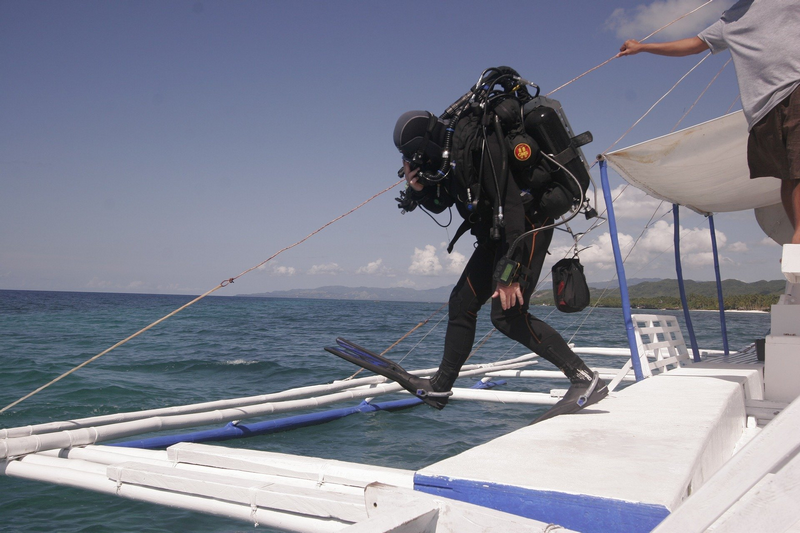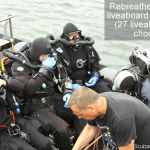
You may be thinking about switching from diving on an open-circuit scuba tank to using a closed-circuit rebreather system instead. But as with any change from one system to another, it’s a good idea to know what the advantages might be, which in this case is to know what the benefits are of a rebreather.
The best way to do more rebreather diving is to book yourself on a scuba diving liveaboard. You can check the latest and best deals on liveaboards using the following window:
The main benefits of using a rebreather include:
- No bubbles means reduced noise levels so you get closer to marine life.
- Longer no-stop dive times.
- Reduced decompression times.
- Less risk of nitrogen narcosis.
- Lighter than scuba dive tanks.
- Gas consumption doesn’t change with depth.
- Reduced dehydration as the gas breathed is moist.
- Improved safety with the reduced risk of decompression sickness.
- Stay warmer as the gas breathed is warm.
- Reduced fatigue.
Let’s look at each of the benefits of using a rebreather in more detail.
1. Rebreathers don’t produce noisy bubbles so you can get closer to marine life
The benefit of a rebreather is that it is doesn’t produce noisy exhaust bubbles, which means you can get closer to marine life without disturbing them, as rebreathers are silent when compared to a scuba breathing apparatus.
If you love to scuba dive with sharks, this will help you get closer to the sharks. The sharks will feel less threatened and will swim closer to you too.
Getting close to marine life is particularly applicable with hammerheads, as hammerhead sharks are shy creatures and the bubbles from a scuba unit tend to frighten them away.
If you are an underwater photographer, you may prefer to dive with a rebreather, as you are more likely to get close to sea creatures for those close-up pictures.
2. Rebreathers benefit by longer no-stop dive times
Divers that use rebreathers can dive for longer with no-stop decompression dive times, which is as a result of the efficient use of gas mixes appropriate for the diver’s depth. The rebreather is always applying the most optimal mix of gas for each depth.
3. Rebreathers reduce decompression times
Rebreathers reduce decompression times, as they apply the best gas mix for the diver’s depth. The gas mix supplied to divers from a rebreather at the different depths includes pure oxygen to replenish oxygen used by the diver, plus other gasses depending on the depth of the dive.
In addition to replenishing the oxygen depleted from exhaled air by the diver, the rebreather unit may also add either nitrogen-oxygen (nitrox) or helium-oxygen (heliox) in appropriate mixes to optimise the partial pressure of oxygen to keep the diver safe, plus to minimise nitrogen levels to reduce nitrogen absorption.

4. Divers are less likely to suffer from nitrogen narcosis using a rebreather
Divers using rebreathers are less likely to suffer from nitrogen narcosis (or raptures of the deep), as rebreathers are constantly optimising the mix of gasses a diver is breathing at different depths. This includes a reduced percentage of nitrogen in the gas, which reduces nitrogen absorption by the diver, which is the cause of nitrogen narcosis.
5. Rebreathers are lighter than scuba dive tanks
The weight of rebreathers is less than that of scuba tanks, especially when compared to the use of twin-sets or additional sidemount dive tanks used by technical divers for deep diving. Rebreathers also take up less space, especially when compared to the number of scuba dive tanks necessary for technical deep dives.
6. The gas consumption doesn’t change with depth for rebreathers
With a rebreather your gas consumption will remain the same regardless of depth, as you only use the oxygen the body needs according to your physical effort on the dive.
Any unused oxygen is exhaled and recycled through the rebreather and the used O2 is replenished from the oxygen cylinder. Whereas with a scuba unit the gas consumption increases with depth.
7. Rebreathers reduce dehydration as the gas breathed is moist
Unlike a scuba unit which uses dry gas, a rebreather supplies warm moist gas, which means you are less likely to get dehydrated on a dive. The added benefit of not being dehydrated is the reduced risk of decompression sickness.
8. Rebreathers offer improved safety with a reduced risk of decompression sickness
Rebreathers offer improved diver safety and a reduced risk of decompression sickness, as the unit is always applying the optimal mix of gasses at each depth of the dive, including reduced levels of nitrogen which is the cause of decompression sickness.
9. Rebreathers keep divers warmer as the gas breathed is warm
A rebreather will keep you warmer, as the gas delivered from a rebreather is warm vs the cold dry gas supplied by an open-circuit scuba cylinder.
10. Divers suffer less fatigue when diving on a rebreather
Due to the fact that rebreathers are constantly optimising the mix of gasses a diver is breathing at different depths, it means divers suffer less physiological stress from the depth of dives, resulting in less fatigue.
Divers using rebreathers absorb less nitrogen too, as the rebreather reduces the level of nitrogen a diver breaths by adding more oxygen to the gas mix, which offers the same benefit of diving on nitrox, resulting in reduced tiredness caused from less nitrogen absorption.
Additionally, as the rebreather unit is lighter than the equipment used by tech divers on scuba units, this will fatigue divers less too.
Are rebreathers worth it?
Rebreathers are worth it when you consider the main benefits of using a rebreather, which includes silent diving so you get close to marine life, increased no decompression bottom time, reduced diver fatigue and reduced risk of decompression sickness.
As part of your research into rebreathers, you may also want to read more about how rebreathers work and how long you can dive on a rebreather too.
Also, if you choose to dive with a rebreather, there are dive liveaboards that cater to rebreather divers and offer rebreather support. For example, if you like diving in the Red Sea, there are 29 Red Sea liveaboards with rebreather support. Plus in the Maldives there are 7 Maldives liveaboards with rebreather support.
I hope you enjoyed this page about what is the benefit of using a rebreather
If you have more questions either about snorkelling or scuba diving (or specifically about what is the benefit of using a rebreather), please comment below with your questions.
Please share your experiences, plus dive sites, resorts and liveaboards you recommend. Share the time of year of your trip together with what you saw, the visibility, currents and dive operator, as this will help others who read this page.
There will also be many more pages and articles about scuba and scuba diving safety tips (and on snorkelling too) for you to read and learn about this fabulous sport.
Have fun and be safe!




